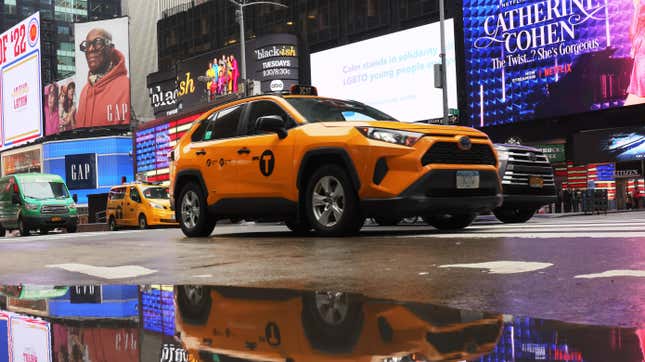
New Yorkers looking to catch an Uber may soon find themselves sitting in the back of classic Yellow Cab.
The ride-hailing giant has announced it will list all New York City taxis, including the iconic yellow cabs, on its app starting later this Spring. The agreement, first revealed by The Wall Street Journal on Thursday, represents one of the most significant partnerships between New York’s taxis and Uber since the company first arrived in 2011. But remember, Uber says it’s totally not a transportation company. Right.
As part of the new agreement, the New York City Taxi and Limousine Commission will integrate their current ride-hailing technology provided by Curb and CMT with Uber. That will reportedly add around 14,000 taxis to Uber’s arsenal, a huge gain, particularly as the industry struggles with driver shortages caused by the pandemic.
When the service launches, Uber says passengers should expect around the same fare as they would for an UberX ride. Taxi drivers who respond to requests using Uber’s app will see a trip price upfront and will have the option to confirm or reject it. (Non-taxi Uber drivers don’t have that same ability to see fare prices ahead of time and decline rides they don’t deem worth it). Cab drivers can also snub the app entirely and pick up riders on the street. It’s not all good news for drivers though. Taxi drivers providing services through the app won’t be eligible for Uber’s recently announced fuel surcharge meant to aid drivers struggling with record-high gas prices.
Uber, of course, isn’t doing any of this for free. The company and the taxi partners will reportedly take a cut of each ride, though the specific percentage remains unclear. Uber didn’t answer when Gizmodo asked for specific details around the new agreement’s pay structure.
Instead, in an email to Gizmodo, Uber described the deal as a win-win, providing riders more vehicle options to choose from on the one hand while simultaneously exposing drivers to more rider demand on the other. Though this marks the first citywide agreement of its kind in the U.S, Uber said it works with taxi software and fleet operators in dozens of countries and sees them as key to opening up new markets. That’s ironic coming from a company who once dreamt of disrupting the industry into oblivion. In the Journal interview, Uber now says it wants to list every taxi in the world on their app in the next five years.
“Uber has a long history of partnering with the taxi industry to provide drivers with more ways to earn and riders with another transportation option,” Uber Senior Vice President of Mobility and Business Operations Andrew Macdonald, told Gizmodo in a statement
Uber’s efforts to add NYC taxi cabs to its apps date back to at least last September according to lobbying disclosure spotted by The New York Post. Riders actually were able to select yellow cabs from the Uber app in the past, though earlier efforts were subject to several lawsuits.
The new deal marks a major shifting of the tides in the relationship between New York’s cab industry and the Silicon Valley-based app. New York initially fought to impede Uber’s growth when it first arrived on city streets but to no avail. Uber eventually surpassed yellow cabs in terms of average daily ridership for the first time in 2017.
The pandemic and ensuing national labor shortage have caused problems for Uber as of late though. In January, the number of unique rideshare drivers was down 45% compared to pre-pandemic, August 2019 levels, according to research from firm Gordon Haskett viewed by the Wall Street Journal. That was already starting to improve, but the new influx of yellow cab drivers will undoubtedly accelerate Uber’s recovery.